
Rampart
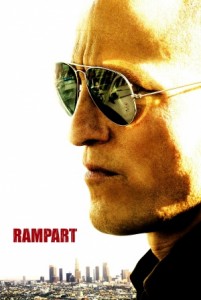
Plot: Dave Brown (Woody Harrelson) is a dirty cop working for the LAPD. In his words, he’s the last of the greats. His pigheadedness constantly gets him into hot water not only with his work, but his family. After beating a man half to death over a car accident, he’s put into the (media) line of fire and his days as a cop seem to be numbered. Making matters worse is his daughters’ disgust with him and their mother’s shunning of him.
Review: “Rampart” starts off by showing great promise. Oren Moverman seems to be partaking in an extensive character study of a dirty cop. The corrupt cop is nothing new and neither is deeply showing the ramifications of their actions. Even so, Oren was on to something and cooking up quite a feast. By making us hate Dave and question his every move, we’re not only engrossed in his endeavors, but also a bit frightened.
A lot of this can be attributed to Woody Harrelson, who does a magnificent job as Dave Brown! The only reason he doesn’t get full credit is because it’s Oren’s direction that helped actualize the character. Woody simply stepped into his shoes and took over. He consumed the character or, better yet, let the character consume him. His actions aren’t what’s frightening. It’s the simple scenes where he’s drinking at a bar and shifting his eyes, clearly about to snap. Watching the veins on his head pulsate with rage makes one wonder if he’s going to snap at any second.
If the film would have remained as a character study on Brown, I’d be singing it’s praises. Unfortunately, that’s not the case. Once the beating occurs and Dave’s put under the microscope, the film loses it’s edge. It falls in line to an average crime drama where Dave’s past actions and current ones get him into hot water. This is all fine and dandy, except that we’re now supposed to root for him. By having his vicious assaults targeted at those with bad intentions, we’re supposed to take sides with him. We’re supposed to believe his theories of him constantly being set up and hope he overcomes his problems.
The fact of the matter is I didn’t want to cheer for Dave Brown. I wanted to hate him. I was doing so in the first half of the film and I was loving every second of it! He was a sexist, racist, violent, narcissistic asshole who would piss on a homeless man if he felt like it. There’s nothing of value to find in him, which is the point. He may be a terrible person, but it’s interesting to dissect him and watch his every move. To see what makes him tick.
Take for example his office nickname. His partners have dubbed him “Date Rape” Dave (which his daughter also calls him, much to his chagrin). The reasoning for this is a long-standing rumor that he killed a suspected date rapist. As I watched Dave purvey women and use them as his sexual fodder, I began to wonder if his nickname had a much deeper, sinister meaning. That thought gets eradicated shortly after it’s revealed the true reasoning is the one given earlier.
Oren Moverman is a good director. He crafts some elegant and poignant shots, such as the hypnotic club sequence and the spinning camera in an interrogation meeting that represents the dizzying revolving door that is the justice system. He utilizes actors such as Sigourney Weaver, Steve Buscemi and Ice Cube well. They actually serve a purpose instead of proving a “hey look, a star” response. What he seemingly lacks is confidence. Instead of taking a risk with the character study, he nestles into the safety net that is the crime drama. One that’s fine for what it is, but isn’t what “Rampart” should have been about.
Final Rating: C+
Evidence
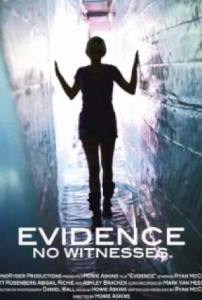
Plot: Four friends (Ryan McCoy, Brett Rosenberg, Abigail Richie, Ashley Bracken) embark on a camping trip. This being Brett’s first, Ryan has the grand idea of documenting it. As the festivities begin, they notice they’re not alone and are being hunted.
Review: I’m fond of the found footage subgenre. When done correctly, it can enhance the experience and, more importantly, the tension and thrills most commonly found in regular horror films. By putting the viewer in the action, it’s easier to relate to the characters. Or, at the very least, relate to their predicament. With the subgenre taking of wildly the past few years, it’s harder to like it thanks in part to many lackluster efforts. “Evidence” is not one of them.
Howie Askins is no slouch. He knows how to utilize the found footage aspect well and induces many thrills and tension from it. He also pokes fun at the subgenre, making the film almost a self-parody. Don’t let that fool you. “Evidence” is a horror film through and through. One that takes risks instead of opting for the safe route. They don’t all pay off, but it’s admirable to see a director confident in testing the boundaries.
The build up to the payoff is done splendidly. The four characters are your average twenty-something year olds. They drink and act stupid, but do have a semblance of intelligence to them. They’re all likable, outside of Ryan, who’s meant to be reviled. His selfish desire to make this documentary puts his friends lives in danger to the point where you wish one of them would break the camera (though you’re glad they didn’t, given what it captures later on). He comes very close to being unbearable, buy Askins wisely steps in to tarnish that from happening.
Once the action picks up, it’s a nonstop thrill ride. You’re not going to be screaming and shouting as much as you are saying, “What the hell?!?” Askins throws everything against the wall, with most of it sticking. I won’t reveal any of the surprises, as that’s easily the best part. I will state that the main attraction is superb and spellbinding! The side dishes that come with it are less satisfactory.
“Evidence” may fall in line with the usual faults of found footage films (characters becoming annoying, some scary moments failing), but it stands out from the pact. It’s inventive, smart and captivating. Askins even slyly pokes fun at today’s obsession with documenting everything. Ryan wanting to document a camping trip, a mundane task to put on film, is evident of that. It’s stuff like this that make “Evidence” worthwhile!
Oh, and before I forget. I must give major props to Howie Askins for having the camera take damage. Not only that, but the longer the film goes (which isn’t too long, as it has a lean seventy-six minute running length), the more damage it takes. By film’s end, the camera is showing the wares and tares of the blemishes it has received.
Final Rating: B
The Interrupters
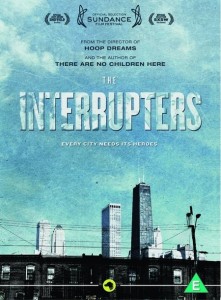
Plot: Steve James follows a year in the life of Chicago, Illinois. The city has been plagued with violence and homicide, which has prompted concerned citizens to fight back. They form the “Violence Interrupters”, a group who do their best to calm down a fight and gang warfare to reduce the damage. Many of them are former convicts and gang members wanting to make a difference and save the lives of those in need.
Review: Before I start this review, it must be said that I watched the two hour and five minute cut of the film. There is a version out there that is much longer that was seen at film festivals such as Sundance. Once PBS picked it, they had it trimmed down to a two hour documentary. I decided to review this version as it’s the most easily accessible for the public.
With that being said, the two hour running length is not an issue. It’s clear there’s more footage that wasn’t used, mainly since the documentary spans an entire year (starting in Summer and ending in Spring). Steve James (the director) and Aaron Wickenden had a helluva task ahead of them in editing all of the content. They do a magnificent job of not only choosing the footage, but interconnecting them. The film even closes with an epilogue that closes each chapter.
The main focus is on the members of the “Violence Interrupters”. Their back stories are briefly detailed and interviews with each of them shows why they’ve chosen this initiative. Due to their history in gangs and imprisonment (one man, Cobe Williams, was sentenced for twelve years on drug trafficking and attempted murder charges), they’re able to connect with the troublemakers. Their goal isn’t to break up the gangs. It’s simply to eradicate the murders that come from within.
It’s amazing to watch as they deal with visibly angry and upset individuals who are ready to snap. One in particular, nicknamed “Flamo”, is ready to burst and shoot those responsible for injuring his brother. Two of the “Violence Interrupters” are able to calm him down and derail him from the wrong track. It takes awhile for them to work their magic, but their persistence pays off.
Another angle follows an eighteen year old named Caprysha who is struggling with drug abuse that’s run in her family. When one of the “Violence Interrupters” acts as a guidance counselor to her, she’s able to motivate her and take the right path. She hits a few bumps in the road and naturally acts as a frustrated teenager, giving up at quite a few points. Her counselor (of sorts) sticks with her, helping to pick her back up.
If you’re like me and are sensitive, you may want to have a few tissues in hand. Within the first few minutes I was welling up. It’s hard not to shed some tears as you see these unfortunate events unfold. Watching a teenager being beaten to death for no apparent reason and seeing the ramifications surrounding it is heartbreaking. It’s not as if Steve James is manipulating the audience. He doesn’t force any of this upon us. He just lets it flow, captivating the audience. That’s the true beauty of “The Interrupters”!
Final Rating: A+
Wreckage
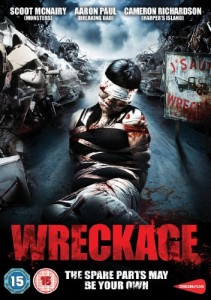
Plot: When their car breaks down, four friends (Mike Erwin, Aaron Paul, Kelly Kruger and Cameron Richardson) head to a junkyard to hunt for spare parts. Unbeknownst to them, a serial killer is on the loose and is residing in the junkyard. He sets his sights on the unsuspecting teens, hunting them down one by one.
Review: I knew going into “Wreckage” that it already had one plus going for it; the setting. I’m a sucker for a good setting in a slasher flick. Anything that isn’t run of the mill (such as a sleepy town or a summer camp) is guaranteed to pique my interest. The rest of the film can be an abysmal failure, but I’ll have at least walked away seeing a new setting. Something as trivial as that can make a huge difference.
Thankfully, the setting isn’t all that “Wreckage” has going for it. While it’s not a terrific slasher, it’s a serviceable one that works perfectly on a rainy night. The standard archetypes are represented. The basic storyline of friends being deserted and hunted by a madman. A killer with a distinguishing look (our villain here wears a welder’s mask with the visor poked out so he can see) that carves his own niche (the use of automobiles and auto parts). The disgruntled old sheriff (this time played by Roger Perry) who is suspicious of the youngsters and shoves a gun in their face any chance he gets. We even have a stereotypical hillbilly on hand (this time played by Scoot McNairy) who provides comic relief (Scoot’s voice itself provides fits of laughter).
John Mallory Asher knows that he’s directing a slasher flick. More importantly, he knows this isn’t “Halloween” or “A Nightmare on Elm Street”, where tension and atmosphere provide the chills. This slasher film relies on “boo” scares (though not too many) and grotesque murders to thrill it’s audience. For the most part, the kills are substantial and creative. One even reminded me of the most famous scene from “The Hitcher”. There is one that ends in a cop out, but the majority of them are good.
Where Asher falters is in giving the killer a back story. As film critic James Berardinelli states, the less you know about the killer, the scarier he/she is. Giving the audience more information makes them less frightening. The film starts by showing the killer as a young kid who is abused by his trailer trash mother and her boyfriend. When is his brother is attacked, he pulls out a gun and shoots them both. We jump ahead about fifteen years into the future and are constantly teased on who the killer is. The reveal, as well as the twists and turns leading up to it, is convoluting and frustrating. One wonders why Asher didn’t stick with the formula. It may be generic, but it works.
Up until the aggravating plot twists, “Wreckage” is a fun little slasher flick. You get hammy acting, though none of it is outright terrible. I’d argue that Scoot McNairy’s performance is actually good, as he purposely chews up the scenery and actually makes the comic relief funny (though results may vary). The rest of the crew are nothing short of average, though that’s fine in a production like this. All that truly matters is the setup and the payoff. Here, it’s done marginally well.
Final Rating: B-
I Melt With You
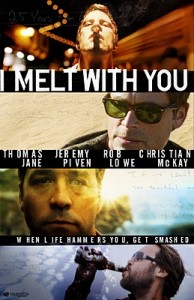
Plot: Old college buddies, Richard (Thomas Jane), Jonathan (Rob Lowe), Ron (Jeremy Piven) and Tim (Christian McKay) get together once a year for one week to catch up on life. Now in their forties, they all suffer from mid-life crises. By drowning themselves in drugs and alcohol, they forget their worries, only to cause more.
Review: Let it be known my problems with “I Melt With You” don’t center around the fact that the protagonists are suffering from mid life crises. I can understand how some will view an opinion a twenty year old such as myself as frivolous since I can’t relate to the characters. I’d agree with you on that. I wish that were my main concern with the film. It’s far removed from that.
My main concern is the inchoate direction of Mark Pellington, who also penned the script (along with Glenn Porter). Instead of developing the characters from the start, he throws them into a bombastic state of partying. Not until after they get drunk and high does he touch upon their problems. This method can, and has, worked, but not here. The problems that arise feel forced and half-assed. As if they were thought of on the spot. Not helping matters is that, just as we get comfortable with them, they go back into another haze. This makes it incredibly difficult for us to connect emotionally with the quartet.
It’s not the actors don’t try. On the contrary. They bust their asses off! They just don’t have good material to work with. They’re told to scream and shout to express their emotions. This works in spots, but becomes repetitive and derivative after awhile. Jeremy Piven is the only one who’s allowed to show some constraint and even that doesn’t last long. It’s my belief they’re told to holler up a storm to keep the audience awake. This would also explain the soundtrack being cranked up to eleven.
To call back on my age, I felt during the entire duration of the film that the screenwriters were people in their twenties. Not only do the rants and philosophies of the four men resemble that off a freshly minted college graduate’s views on life (usually inspired by their professors), the twenty year olds that crash the party have the best dialogue. Their outlook on life is intelligent and optimistic, strengthened by their accomplishments (such as having a story printed in “The New Yorker”). Once I discovered that Mark Pellington is in his forties, I was stunned. The only explanation I could come up with is he was trying to capture the clash between youth and middle age. If that’s the case, he failed.
“I Melt With You” is bereft of drama and insight. The only thing keeping it afloat are the performances and the soundtrack (which, considering this isn’t a musical, is a detriment). It’s a shame to see such talent wasted in a languid film. I’m not just referring to the main four, but to Carla Gugino as well, who’s basically an afterthought as Officer Boyde (which seems to be a pattern for her film career as of late). The film itself is just that; a hazy afterthought.
Final Rating: C-
